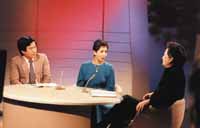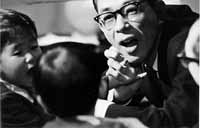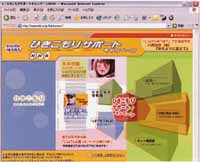|
Cultural programs
In 1962, Culture
Special began covering a wide range of topics, from current social,
economic and political issues to culture, history and the arts. For
16 years, the show accurately reflected contemporary interests and concerns.
University Correspondence Course,
which went to air in 1965, had the more specific goal of enabling adult
learners to benefit from university courses. Its use of leading lecturers
and research experts is continued today by NHK
Public Seminar. Cultural and educational programs like these
offer the intellectual challenges and opportunities for which NHK Educational
TV is known.
Arts programs
When Educational TV switched to color in
1976, arts programs were among the first to benefit. One regular feature
was Sunday Arts Gallery, which included
a 45-minute segment called My Favorites
in which a distinguished guest would chat informally about his or her
favorite artworks, and a 15-minute segment called This
Week's Gallery that introduced current exhibitions. The first
broadcast of the show featured art and literature critic Usui Yoshimi
chatting about Rokuzan, whose real name was Ogiwara Morie. Later editions
included actor Takizawa Osamu speaking about van Gogh, and poet Terayama
Shuji reflecting on Magritte. This show created a lot of interest among
viewers and became a fixture on Sunday mornings.
In addition, NHK broadcast a series of specials
on major museums overseas, including The
Louvre Museum, Orsay Museum,
The Florentine Renaissance, and Prado
Museum. Now arts programs have entered the era of Hi-Vision (HDTV)
production, offering viewers an even more vivid look at art and artists
in Japan and the world.
Language programs
NHK's first language program was the schools
broadcast English Room in 1953. English
language programs had in fact begun even earlier, from the start of
radio, but were halted due to the Second World War. Once they resumed,
they formed a key component of Japan's internationalization. English
courses for the general public started with the launch of Educational
TV in 1959.
|
|
From so-called classroom English, the focus shifted to practical conversation
skills that would enable learners to speak easily and comfortably with
foreigners. Instructors like Matsumoto Toru, Tazaki Kiyotada and Kunihiro
Masao helped to popularize the courses and gave them an important role
in English education in Japan. French and German lessons also started
in 1959, followed in later years by Spanish, Chinese, Russian, Korean
and Italian. Today, classes in eight different languages are available
on television.
Welfare programs
In 1961, NHK started broadcasting TV
School for the Hearing Impaired, a program for families with
hearing impaired children of pre-elementary school age. In an era when
special education for such children was not widely available, this program
showed the effectiveness of speech therapy and helped to pioneer the
establishment of pre-school education departments in schools for children
with hearing difficulties all over Japan. Later programs provided detailed
information about children with speech disabilities (Speech
Therapy Session) and cognitive disabilities (Fun
in the Classroom). In 1977, the much-talked-about For the Hearing
Impaired marked the first instance of a sign language interpreter taking
center-screen. Until then, such interpreters had only ever appeared
in one corner of the picture.
Along with these programs, NHK also reported
on the predicament of the disabled in Japanese society and national
policy towards them, in order to seek public understanding and cooperation.
Programs with this focus started with The
Age of Welfare in 1973, followed by Welfare
in the Future and Future Life Together.
In the 1980's, new programs were oriented toward families with an elderly
member to care for, such as Silver Seat
and Senior Care with a Smile.
|
Shut-in Support Campaign
In 2003, the 50th anniversary of TV broadcasting in Japan, welfare
programming began a new venture with Shut-in Support Campaign,
an innovative welfare service combining TV and the Internet. It
is estimated that Japan has between 500,000 and 1 million "shut-ins"
(individuals who don't go outside their homes). The Shut-in Support
Campaign is rethinking strategies for helping shut-ins by exploring
new ways to deliver useful information to them and their families.
|
|




